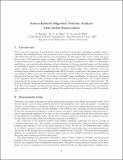| dc.contributor.author | Burdick, S. | |
| dc.contributor.author | de Hoop, M. V. | |
| dc.contributor.author | van der Hilst, Robert D. | |
| dc.contributor.other | Massachusetts Institute of Technology. Earth Resources Laboratory | |
| dc.date.accessioned | 2014-09-30T13:47:26Z | |
| dc.date.available | 2014-09-30T13:47:26Z | |
| dc.date.issued | 2012 | |
| dc.identifier.uri | http://hdl.handle.net/1721.1/90464 | |
| dc.description.abstract | The reverse-time migration of global seismic data generated by free-surface multiples is regularly used to constrain the crustal structure, but its accuracy is to a large extent determined by the accuracy of the 3-D background velocity model used for wave propagation. To this improve the velocity model and hence the accuracy of the migrated image, we wish to apply the technique of migration velocity analysis (MVA) to global passive data. Applications of MVA in the active setting typically focus on o ffset- or angle-gather annihilation, a process that takes advantage of data redundancy to form an extended image, and then applies an annihilation operator to determine the success of image formation. Due to the nature of regional-scale passive seismic arrays, it is unlikely that the data in most of these studies will be su cient to form an extended image volume for use in annihilation-based MVA. In order to make use of the sparse and irregular array design of these arrays, we turn towards a shot-pro le moveout scheme for migration velocity analysis introduced by Xie and Yang (2008). In the place of extended image annihilation, we determine the success of the migration velocity model by using a weighted image correlation power norm. We compare pairs of images formed by migrating each teleseismic source by image cross-correlation in the depth direction. We look for a suitable background model by penalizing the amount of correlation power away from zero depth shift. The total weighted correlation power between source-pro le images is then used as the error function and optimized via conjugate gradient. We present the method and a proof-of-concept with 2-D synthetic data. | en_US |
| dc.language.iso | en_US | en_US |
| dc.publisher | Massachusetts Institute of Technology. Earth Resources Laboratory | en_US |
| dc.relation.ispartofseries | Earth Resources Laboratory Industry Consortia Annual Report;2012-18 | |
| dc.subject | Migration velocity analysis | |
| dc.title | Source-Indexed Migration Velocity Analysis with Global Passive Data | en_US |
| dc.type | Technical Report | en_US |
